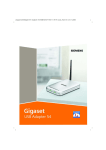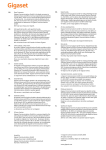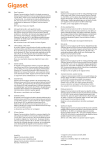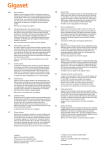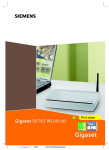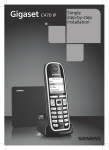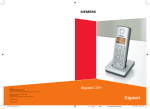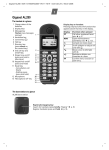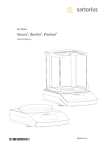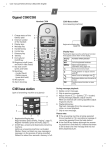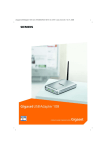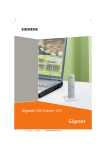Download Installing the Gigaset PC Card 54
Transcript
Schablone 2004_08_26 Gigaset PC Card 54 / englisch / A31008-E505-B101-3x-7619 / cover_front.fm / 14.11.2008 Schablone 2004_08_26 Gigaset PC Card 54 / englisch / A31008-E505-B101-3x-7619 / cover_front.fm / 14.11.2008 Gigaset PC Card 54 / englisch / A31008-E505-B101-3x-7619 / PC_Card_54IVZ.fm / 14.11.2008 Contents Schablone 2004_08_26 Contents Safety precautions . . . . . . . . . . . . . . . . . . . . . . . . . . . 5 Notes on secure operation . . . . . . . . . . . . . . . . . . . . 5 Your contribution to the environment (ECO) . . . . . 5 The Gigaset PC Card 54 . . . . . . . . . . . . . . . . . . . . . . . 7 Wireless LAN Basics . . . . . . . . . . . . . . . . . . . . . . . . . . . . . . . . . . . . . . . . . . . . . . . . . . . . Local Area Network (LAN) . . . . . . . . . . . . . . . . . . . . . . . . . . . . . . . . . . . . . . . . . . . . Ad-hoc network . . . . . . . . . . . . . . . . . . . . . . . . . . . . . . . . . . . . . . . . . . . . . . . . . . . . Infrastructure network . . . . . . . . . . . . . . . . . . . . . . . . . . . . . . . . . . . . . . . . . . . . . . . Security in wireless networksEncryption . . . . . . . . . . . . . . . . . . . . . . . . . . . . . . . . . . . . WEP encryption . . . . . . . . . . . . . . . . . . . . . . . . . . . . . . . . . . . . . . . . . . . . . . . . . . . . WPA encryption . . . . . . . . . . . . . . . . . . . . . . . . . . . . . . . . . . . . . . . . . . . . . . . . . . . . Range of wireless communication via a WLAN . . . . . . . . . . . . . . . . . . . . . . . . . . . . . . . 7 7 8 8 9 9 9 9 Installing the Gigaset PC Card 54 . . . . . . . . . . . . . . 10 System requirements . . . . . . . . . . . . . . . . . . . . . . . . . . . . . . . . . . . . . . . . . . . . . . . . . . Contents . . . . . . . . . . . . . . . . . . . . . . . . . . . . . . . . . . . . . . . . . . . . . . . . . . . . . . . . . . . . Notes on location . . . . . . . . . . . . . . . . . . . . . . . . . . . . . . . . . . . . . . . . . . . . . . . . . . . . . Status displays . . . . . . . . . . . . . . . . . . . . . . . . . . . . . . . . . . . . . . . . . . . . . . . . . . . . . . . Installation procedure . . . . . . . . . . . . . . . . . . . . . . . . . . . . . . . . . . . . . . . . . . . . . . . . . Running installation . . . . . . . . . . . . . . . . . . . . . . . . . . . . . . . . . . . . . . . . . . . . . . . . Connecting the Gigaset PC Card 54 . . . . . . . . . . . . . . . . . . . . . . . . . . . . . . . . . . . . Installing driver software . . . . . . . . . . . . . . . . . . . . . . . . . . . . . . . . . . . . . . . . . . . . Checking installation . . . . . . . . . . . . . . . . . . . . . . . . . . . . . . . . . . . . . . . . . . . . . . . . . . Reading the connection quality from the icon . . . . . . . . . . . . . . . . . . . . . . . . . . . 10 10 10 11 12 12 14 15 16 17 Configuring Gigaset PC Card 54 . . . . . . . . . . . . . . . 18 The Gigaset WLAN Adapter Monitor . . . . . . . . . . . . . . . . . . . . . . . . . . . . . . . . . . . . . . Opening the monitor . . . . . . . . . . . . . . . . . . . . . . . . . . . . . . . . . . . . . . . . . . . . . . . Deactivating Autostart . . . . . . . . . . . . . . . . . . . . . . . . . . . . . . . . . . . . . . . . . . . . . . Operating the Gigaset WLAN Adapter Monitor . . . . . . . . . . . . . . . . . . . . . . . . . . . Closing the monitor . . . . . . . . . . . . . . . . . . . . . . . . . . . . . . . . . . . . . . . . . . . . . . . . Configuration . . . . . . . . . . . . . . . . . . . . . . . . . . . . . . . . . . . . . . . . . . . . . . . . . . . . . . . . Configuration – General . . . . . . . . . . . . . . . . . . . . . . . . . . . . . . . . . . . . . . . . . . . . Configuration – Security . . . . . . . . . . . . . . . . . . . . . . . . . . . . . . . . . . . . . . . . . . . . Configuration – Profile . . . . . . . . . . . . . . . . . . . . . . . . . . . . . . . . . . . . . . . . . . . . . . Status . . . . . . . . . . . . . . . . . . . . . . . . . . . . . . . . . . . . . . . . . . . . . . . . . . . . . . . . . . . . . . IP settings . . . . . . . . . . . . . . . . . . . . . . . . . . . . . . . . . . . . . . . . . . . . . . . . . . . . . . . . . . . Site Monitor . . . . . . . . . . . . . . . . . . . . . . . . . . . . . . . . . . . . . . . . . . . . . . . . . . . . . . . . . About . . . . . . . . . . . . . . . . . . . . . . . . . . . . . . . . . . . . . . . . . . . . . . . . . . . . . . . . . . . . . . 18 18 19 19 20 21 21 24 28 30 31 33 35 3 Gigaset PC Card 54 / englisch / A31008-E505-B101-3x-7619 / PC_Card_54IVZ.fm / 14.11.2008 Contents Schablone 2004_08_26 Uninstalling Gigaset PC Card 54 . . . . . . . . . . . . . . . 36 Uninstalling the software . . . . . . . . . . . . . . . . . . . . . . . . . . . . . . . . . . . . . . . . . . . . . . 36 Completing Uninstall . . . . . . . . . . . . . . . . . . . . . . . . . . . . . . . . . . . . . . . . . . . . . . . . . . 36 Updating device drivers . . . . . . . . . . . . . . . . . . . . . 37 Glossary . . . . . . . . . . . . . . . . . . . . . . . . . . . . . . . . . . 38 Appendix . . . . . . . . . . . . . . . . . . . . . . . . . . . . . . . . . . 45 Trouble shooting . . . . . . . . . . . . . . . . . . . . . . . . . . . . . . . . . . . . . . . . . . . . . . . . . . . . . Specifications . . . . . . . . . . . . . . . . . . . . . . . . . . . . . . . . . . . . . . . . . . . . . . . . . . . . . . . . Software . . . . . . . . . . . . . . . . . . . . . . . . . . . . . . . . . . . . . . . . . . . . . . . . . . . . . . . . . Hardware . . . . . . . . . . . . . . . . . . . . . . . . . . . . . . . . . . . . . . . . . . . . . . . . . . . . . . . . Approval . . . . . . . . . . . . . . . . . . . . . . . . . . . . . . . . . . . . . . . . . . . . . . . . . . . . . . . . . . . . Service (Customer Care) . . . . . . . . . . . . . . . . . . . . . . . . . . . . . . . . . . . . . . . . . . . . . . . Guarantee Certificate United Kingdom . . . . . . . . . . . . . . . . . . . . . . . . . . . . . . . . . . . . Guarantee Certificate Ireland . . . . . . . . . . . . . . . . . . . . . . . . . . . . . . . . . . . . . . . . . . . 45 48 48 48 49 50 50 51 Index . . . . . . . . . . . . . . . . . . . . . . . . . . . . . . . . . . . . . 53 4 Gigaset PC Card 54 / englisch / A31008-E505-B101-3x-7619 / security.fm / 14.11.2008 Safety precautions Schablone 2004_08_26 Safety precautions u The tic can affect medical equipment. Therefore, you should pay attention to the technical conditions of the corresponding environment. u Make sure you include the operating instructions and the CD-ROM, when you pass on your Gigaset PC Card 54 to somebody else. u Dispose of the Gigaset PC Card 54 and any CD-ROMs you no longer need in an envi- ronmentally-friendly manner. u Under no circumstances try to use a damaged device. If in doubt, please contact our service department, see Chapter "Service (Customer Care)" on page 50. Notes on secure operation When you have installed and configured the Gigaset PC Card 54 on your PC, you should perform security settings on the wireless network: u Change the SSID for all of the wireless devices within your network (see "SSID (Serv- ice Set Identifier)" on page 22). u Encrypt the communication over your wireless network (see "Configuration – Security" on page 24). Your contribution to the environment (ECO) We at Gigaset Communications GmbH make our products as environmentally compatible as possible. Our goal is a sustainable process that makes it easier for us to comply with the strict stipulations of the ISO standard 14001 for international environmental management. Further advantages for the ecology u Thanks to a switched-mode power supply, all our routers and repeaters use up to 60% less power and so offer higher energy efficiency. u You can reduce the WLAN's transmitting power for all routers and repeaters and some WLAN clients – depending on the device in question and your PC's operating system. u You can turn off the WLAN completely. 5 Gigaset PC Card 54 / englisch / A31008-E505-B101-3x-7619 / security.fm / 14.11.2008 Schablone 2004_08_26 Your contribution to the environment (ECO) Trademarks Gigaset Communications GmbH is a trademark licensee of Siemens AG. Microsoft, Windows 98SE, Windows ME, Windows 2000, Windows XP and Internet Explorer are registered trademarks of the Microsoft Corporation. Please remember: Trademarks and trade names used in these instructions are meant only to describe the operating steps and this use does not imply that they are freely available. Trademarks and trade names are the property of the corresponding holder of the rights. 6 Gigaset PC Card 54 / englisch / A31008-E505-B101-3x-7619 / introduction.fm / 14.11.2008 The Gigaset PC Card 54 Schablone 2004_08_26 The Gigaset PC Card 54 The Gigaset PC Card 54 is a 54 Mbps WLAN network adapter that is connected to your PC or Notebook via a PCMCIA slot. You can use Gigaset data products to set up a wireless local network (WLAN = Wireless Local Area Network) without having to lay cables. Your Gigaset PC Card 54 can be used to connect your PC to other PCs equipped with wireless network adapters (ad-hoc mode). You can also connect your PC to a wireless router, e. g. to the Gigaset SE505 dsl/cable, for Internet access (infrastructure mode). Since the PCs communicate with each other via radio, it does not matter where they are located, as long as they are within range of the wireless network. Mobile PCs, such as Notebooks, can connect to the WLAN even after changing location. This enables you to use all the files and printers on the network. The Gigaset PC Card 54 works according to the IEEE 802.11g transmission standard and is backwards compatible with the older standard IEEE 802.11b. For network security, wireless transmission can be encrypted using 64/128-bit WEP or the newer WPA standard. These operating instructions contain important information on how to set up a WLAN and to configure your Gigaset PC Card 54. Wireless LAN Basics This section provides basic information on wireless LANs to show the role of the Gigaset PC Card 54 in setting up a wireless network Local Area Network (LAN) A LAN is a network that exists in a limited area. A network is two or more computers which are connected together in order to share files as well as peripheral devices, e. g. a printer. Using the Gigaset PC Card 54 you can communicate with other PCs without having to route network cable. Thus you can take your computer to another place and still remain connected to the network. You can use the Gigaset PC Card 54 in two different ways. On the one hand, you can establish a connection to one or more PCs equipped with wireless network adapters. This is an ad-hoc network. On the other hand, you can establish a connection to an Access Point, which is used to obtain access to an already existing wired LAN (infrastructure network). 7 Gigaset PC Card 54 / englisch / A31008-E505-B101-3x-7619 / introduction.fm / 14.11.2008 The Gigaset PC Card 54 Schablone 2004_08_26 Ad-hoc network In an ad-hoc network, PCs communicate with each other via wireless peer-to-peer connections. An ad-hoc network is set up by participants as and when required. All the PCs must have a wireless network adapter installed, e. g. a Gigaset PC Card 54, a Gigaset USB Adapter or USB Stick 54 or a Gigaset PCI Card 54. Ad-hoc networks are used wherever communication networks have to be set up quickly without any existing network infrastructure and the participants are mobile. Infrastructure network In an infrastructure network, connections between network participants are set up via an Access Point (or several Access Points). The Access Point provides the basis for the wireless network. It controls the connections between the participants and can also establish the connection from the mobile stations of a wireless network to a wired LAN (Ethernet) or the Internet. Roaming Several Access Points can be installed to extend the range of a wireless network. Participants in the wireless network can move freely between the various Access Points without losing contact to the network. As soon as there is a risk of losing contact, the PC automatically looks for another Access Point with a stronger signal. All Access Points and wireless network adapters must have the same SSID. All Access Points must be connected to the same Ethernet network. 8 Gigaset PC Card 54 / englisch / A31008-E505-B101-3x-7619 / introduction.fm / 14.11.2008 The Gigaset PC Card 54 Schablone 2004_08_26 Security in wireless networksEncryption Any network, be it wired or wireless, is exposed to the risk of eavesdropping. Connecting your local network to the public network exposes your data and applications to not inconsiderable risks. As with an individual connection, you should always protect your network PCs against external attacks, e. g. via emails, with a virus scanner. These virus scanners however do not provide any protection against unauthorised access from outside (hackers). To counter this risk, Gigaset data products offer various encryption procedures that largely rule out unauthorised access (hacking) to your wireless network. WEP encryption WEP encryption (Wired Equivalent Privacy) encodes data for sending using a key that you have defined. Once they reach the recipient, who uses the same key, the data are restored to the state before you sent them. Recipients who do not know this key cannot read the content of this data stream or only after a great deal of effort. There are two security levels for calculating the encryption key: u 64-bit mode u 128-bit mode WPA encryption Wireless Protected Access (WPA) is a new standard-compliant solution for greater security in wireless networks. WPA is meant to replace the existing WEP standard (Wired Equivalent Privacy) and offers more reliable encryption and authentication methods. With your Gigaset PC Card 54 you can use WPA encryption regardless of the operating system used. WPA encryption is particularly recommended where the highest security is required. Range of wireless communication via a WLAN The range is up to 300 m in the open. In buildings, the maximum range is up to 30 m. The operating environment, the nature of the rooms and building may reduce the range considerably. You can boost the range of your wireless network by placing a repeater, e. g. a Gigaset WLAN Repeater, at the limit of its range. 9 Gigaset PC Card 54 / englisch / A31008-E505-B101-3x-7619 / installation.fm / 14.11.2008 Installing the Gigaset PC Card 54 Schablone 2004_08_26 Installing the Gigaset PC Card 54 System requirements For operation, you will require: u a PC with at least 466 MHz and one of the following operating systems: Windows 98SE, Windows ME, Windows 2000 or Windows XP u 64 MB RAM, more working memory is recommended u at least 30 MB free hard disk space u a free PC card slot (Cardbus) u a CD-ROM drive or a DVD drive Contents The package contains the following components: u a Gigaset PC Card 54 u a CD-ROM containing installation and configuration software, detailed operating instructions, Adobe Reader to read the operating instructions and the document "Practical tips and configuration examples". u a Quick Installation Guide Notes on location Choose the location of the PC where the Gigaset PC Card 54 will be connected with the fewest obstacles to radio waves. Protect the Gigaset PC Card 54 from dampness. The PC with the Gigaset PC Card 54 should not be placed in the immediate vicinity of other electronic equipment. Electrical equipment can mutually affect each other, and radio waves may impair the functioning of other devices. If your PC with the Gigaset PC Card 54 should be under a desk or in a housing, the range of the wireless network can be affected. For the best possible range, we recommend placing the WLAN components in a central and an open location. 10 Gigaset PC Card 54 / englisch / A31008-E505-B101-3x-7619 / installation.fm / 14.11.2008 Installing the Gigaset PC Card 54 Schablone 2004_08_26 Status displays There are two status displays (LEDs) on the Gigaset PC Card 54 . They are used to display the: u Operating status (PWR), red u Transmission status (ACT), green LED PWR ACT State Meaning Continuously lit Off Flashing Off The Gigaset PC Card 54 was installed successfully on your PC and is ready for operation. The device is not ready for use. Data is being transmitted. There is currently no data traffic. 11 Gigaset PC Card 54 / englisch / A31008-E505-B101-3x-7619 / installation.fm / 14.11.2008 Installing the Gigaset PC Card 54 Schablone 2004_08_26 Installation procedure Please remember: Do not insert the Gigaset PC Card 54 into a PCMCIA slot on your PC until the installation software prompts you to do so. First, the software included in the scope of delivery must be installed. This software not only includes the driver software for the device, it can also be used as a configuration and monitoring tool, the Gigaset WLAN Adapter Monitor Only this software has been written especially for the Gigaset PC Card 54. There are similar drivers available in the Windows driver database. But, as a rule, such drivers do not fully cover all the features or function in a different manner. Do not connect the Gigaset PC Card 54 to your PC until prompted by the installation program. If you connect the Gigaset PC Card 54 to your PC before installing the software, Windows will automatically recognise the device and show the dialog box prompting for the appropriate driver. Click on Cancel to close the dialogue. Remove the Gigaset PC Card 54 from the PC and install the software. Please remember: You may require administrator rights for the installation process on your PC. Information for users with Windows 98SE/ME: If you are prompted to restart your computer during installation, click on Restart. After this, installation continues automatically.You should now follow the instructions and steps shown below. Have your Windows Installation CD on hand. You may be prompted to insert it. Running installation ì Close all running programs. ì Insert the CD-ROM supplied into the CD-ROM drive of your PC and wait until the welcome screen appears. If this screen does not appear automatically, start installation manually: – Open Windows Explorer. – Select the CD-ROM drive. – Double-click start.exe. The language selection screen appears ì Select the language. You will now see a screen showing the contents of the CD-ROM. 12 Gigaset PC Card 54 / englisch / A31008-E505-B101-3x-7619 / installation.fm / 14.11.2008 Schablone 2004_08_26 Installing the Gigaset PC Card 54 Installation Install the software for your Gigaset PC Card 54. User guide This opens the detailed operating instructions on the CD-ROM. If you cannot open the detailed operating instructions on the CD-ROM, you will have to install the free Adobe Reader. Practical Tips and Configuration Examples Here you will find solutions to various problems. Install Adobe Reader Install Adobe Reader, Version 6. Browse CD If you are looking for a particular file on the CD-ROM, you can display the CD-ROM contents in an Explorer window. Back The program returns to the language selection screen. Exit This closes the program. ì Click on Installation. Note: The screens for the various operating systems differ only marginally. Installation is largely automatic, apart from a few mouse clicks and restarts. The InstallShield Wizard appears. ì Click on Next to continue installation. The licence agreement screen now appears. ì If you accept the licence agreement, click on Yes. 13 Gigaset PC Card 54 / englisch / A31008-E505-B101-3x-7619 / installation.fm / 14.11.2008 Installing the Gigaset PC Card 54 Schablone 2004_08_26 In the next screen, choose the directory for the installation. ì Click on Browse, if you want to select another directory. Click on Next to continue installation. During installation, the InstallShield Wizard uses the screen Setup progress to show which action is being carried out, and the progress is also displayed. After this stage of installation is completed, a message appears prompting you to connect the Gigaset PC Card 54 to your PC. Connecting the Gigaset PC Card 54 ì Insert the Gigaset PC Card 54 in the PCMCIA slot on your PC. 14 Gigaset PC Card 54 / englisch / A31008-E505-B101-3x-7619 / installation.fm / 14.11.2008 Installing the Gigaset PC Card 54 Schablone 2004_08_26 Installing driver software Once the Gigaset PC Card 54 has been plugged in, installation continues automatically. The operating system's automatic hardware recognition opens to install the drivers for the Gigaset PC Card 54. ì Depending on the other settings for your PC, an additional dialog box may appear. Select the Install software automatically option, and click on Next. If the window does not appear, the installation step described here is automatically carried out by the system. Please remember: u Under Windows 98SE / ME:You may be prompted to insert your Windows Installa- tion CD to continue driver installation. Therefore you should have this CD handy or enter the path name where the Windows installation files are stored on your PC. u Restart your PC if you are prompted to do so. u If your PC already contains more recent files, answer the question whether you want to keep them with YES. After installation, a message will appear prompting you to complete installation. ì Click on Finish. This closes the installation program. Depending on the Windows operating system version you are using, you may also be requested to restart your PC. 15 Gigaset PC Card 54 / englisch / A31008-E505-B101-3x-7619 / installation.fm / 14.11.2008 Installing the Gigaset PC Card 54 Schablone 2004_08_26 Checking installation If installation was successful, you can now use the Gigaset WLAN Adapter Monitor. With the Gigaset WLAN Adapter Monitor you can configure your Gigaset PC Card 54 and create a connection to other network adapters or an Access Point. The Gigaset WLAN Adapter Monitor is represented by an icon in the status area of the taskbar, this icon shows you if there is a connection to a connection partner and the quality of the connection. In a wireless network using only Gigaset products and where the standard settings were used (e. g. no encryption), the connection to an Access Point is set up automatically during installation. The following may be displayed in the status area of the taskbar: The Gigaset WLAN Adapter Monitor icon is not displayed. ü ì First try to open the Gigaset WLAN Adapter Monitor manually, see Chapter "Opening the monitor" on page 18. If this fails, then something went wrong during installation. ì Deinstall the software, see Chapter "Uninstalling the software" on page 36. ì Then install the software again, see Chapter "Running installation" on page 12. The Gigaset WLAN Adapter Monitor icon is displayed in the taskbar, with a red ball above the icon: The Gigaset WLAN Adapter Monitor is installed; the Gigaset PC Card 54 has not been inserted or inserted incorrectly. ì Check that the card is correctly positioned. The Gigaset WLAN Adapter Monitor icon is displayed in the taskbar, with a red cross above the icon: The Gigaset WLAN Adapter Monitor is installed and active; there is no connection to the local network. ì Turn to Chapter "Configuring Gigaset PC Card 54" on page 18. The icon is displayed in the taskbar, with a green ball above the icon: The Gigaset WLAN Adapter Monitor is installed and active; there is no connection to the local network. The number of bars displayed in the icon shows the connection quality. You are advised to read Chapter "Notes on secure operation" on page 5. 16 Gigaset PC Card 54 / englisch / A31008-E505-B101-3x-7619 / installation.fm / 14.11.2008 Schablone 2004_08_26 Installing the Gigaset PC Card 54 Displaying QuickInfo for the connection If you point the mouse over the icon in the taskbar, you will see a small window that displays the connection properties. The following properties are shown: u SSID (Service Set Identifier) in the Connection line u the transmission rate (in Mbps) in the Speed line u the transmission quality (in %) in the Link quality line If there is no connection, you will see a red cross over the icon and in QuickInfo, Disconnected is displayed. Reading the connection quality from the icon The icon changes gradually depending on the current connection quality. The better the connection quality, the higher the transmission speed With reasonable to poor connection: ì If possible, move your PC closer to the connection partner for greater field strength. No WLAN available (red cross over bar) There is no WLAN within range of your Gigaset PC Card 54 that you could connect to. ì Check the configuration of the Access Point and adjust the Gigaset PC Card 54 settings accordingly. Or ì Change your location to reduce the distance to a connection partner. 17 Gigaset PC Card 54 / englisch / A31008-E505-B101-3x-7619 / configuration.fm / 14.11.2008 Configuring Gigaset PC Card 54 Schablone 2004_08_26 Configuring Gigaset PC Card 54 The Gigaset WLAN Adapter Monitor You can use the Gigaset WLAN Adapter Monitor to configure and monitor your Gigaset PC Card 54. Opening the monitor In the standard setting, the Gigaset WLAN Adapter Monitor is opened automatically in the background when you launch your PC. The Gigaset WLAN Adapter Monitor icon is displayed in the status area of the task bar. ì Double-click on Gigaset WLAN Adapter Monitor icon in the status area of the taskbar to open the monitor user interface. Or ì Right-click on the Gigaset WLAN Adapter Monitor icon in the status area of the taskbar. In the pop-up menu, you will see the available tabs and the option Exit. ì In the pop-up menu, click on the appropriate tab to open the monitor user interface and display this tab directly. Use the option Exit to close the Gigaset WLAN Adapter Monitor. If you do not see the Gigaset WLAN Adapter Monitor icon in the status area of the taskbar, you will have to run the program first: ì In the start menu, click on Start – Programs – Gigaset PC Card 54 – Gigaset WLAN Adapter Monitor. This launches the program. The Gigaset WLAN Adapter Monitor icon is displayed in the status area of the task bar. 18 Gigaset PC Card 54 / englisch / A31008-E505-B101-3x-7619 / configuration.fm / 14.11.2008 Configuring Gigaset PC Card 54 Schablone 2004_08_26 Deactivating Autostart The Gigaset WLAN Adapter Monitor is opened automatically every time you power up or reboot your PC. If you do not need the monitor all the time, you can deactivate Autostart. ì Select Start – Programs – Autostart. ì Right-click the Gigaset WLAN Adapter Monitor entry. ì Choose Delete to remove the link to Gigaset WLAN Adapter Monitor from Autostart. Now that the monitor is no longer opened automatically when you launch your PC, you will have to open it manually when you need it. Operating the Gigaset WLAN Adapter Monitor In the Gigaset WLAN Adapter Monitor user interface you will find various settings and status displays for your network adapter in various tabs which will be described in detail in the following. 19 Gigaset PC Card 54 / englisch / A31008-E505-B101-3x-7619 / configuration.fm / 14.11.2008 Schablone 2004_08_26 Configuring Gigaset PC Card 54 Buttons With the buttons under each tab you can use one of the following options: The wireless operation of the network adapter is activated (green icon). The PC is available on the network. ì Click on Radio On to deactivate the wireless operation of the network adapter. Radio Off is now displayed. The PC is no longer available on the network. The wireless operation of the network adapter is deactivated (red icon). The PC is not available on the network. ì Click on Radio Off to activate the wireless operation of the network adapter. Radio On is now displayed. The PC is available on the network. Use the Help button to open the Gigaset WLAN Adapter Monitor help file. Use the Hide button to close the user interface of the Gigaset WLAN Adapter Monitor. The icon in the status area of the task bar shows that the monitor is still active in the background. ì Double-click this icon if you want to open the Gigaset WLAN Adapter Monitor user interface again. Closing the monitor ì Right-click on the Gigaset WLAN Adapter Monitor icon in the status area of the taskbar. This opens the pop-up menu. ì Select Exit to close the program. The Gigaset WLAN Adapter Monitor is closed. The icon disappears from the status area in the taskbar. 20 Gigaset PC Card 54 / englisch / A31008-E505-B101-3x-7619 / configuration.fm / 14.11.2008 Configuring Gigaset PC Card 54 Schablone 2004_08_26 Configuration In the Configuration tab, you can choose the general basic settings and the security options for operating the Gigaset PC Card 54. The Configuration tab is divided into three sections: Configuration – General Successful communication in a WLAN depends on all the PCs using the same ID (SSID) and the same radio channel. In addition, the connected PCs must coordinate their transmission rate for successful data transfer. You can choose the basic settings for each profile in Common of the Configuration tab. Please remember: For security reasons, installation should be followed by changing the SSID of your WLAN, as the default SSID may also be known to unauthorised persons. 21 Gigaset PC Card 54 / englisch / A31008-E505-B101-3x-7619 / configuration.fm / 14.11.2008 Schablone 2004_08_26 Configuring Gigaset PC Card 54 SSID (Service Set Identifier) The SSID is the ID used for the unique identification of a wireless network (WLAN) so that this network can be distinguished from a parallel network. Within a WLAN, all the network adapters must have the same SSID. ì In the SSID field, select the ID of the partner you want to connect your PC to. The default setting is ConnectionPoint. The order for defining the SSID depends on the Network Mode of the WLAN: u Infrastructure: The SSID must be defined on the Access Point first. This SSID is then assigned automatically to every network adapter registering with it. u AdHoc: It is important that all network adapters use the same SSID. The order of entry is irrelevant. Operating mode ì Enter the Network Mode for the network environment: – Infrastructure: There are wireless (WLAN) and wired (LAN) PCs in the network environment. The connection between WLAN and LAN is set up via an Access Point. – AdHoc: The network environment does not have a fixed structure, but is set up between the available wireless network adapters as and when required. No Access Point is required. The default operating mode is Infrastructure. You will find a detailed description of the operating modes in Chapter "Wireless LAN Basics" on page 7. Transmission rate Transmission rate is the term used to describe the data volume sent per second between two PCs. The transmission rate is measured in Mbps (Megabits per second). ì Select the Transmission Rate: Auto During every transmission, the network adapter checks the connection quality and automatically chooses the most suitable transmission rate. 54 / 48 / 36 / 24 / Use one of these Mbps values to set the maximum value for the 18 / 12 / 11 / 9 / 6 / transmission rate. 5,5 / 2 / 1 If you select 24 Mbps for example, the network adapter tries to use this value for every transmission. The setting prevents a faster transmission rate. As the connection quality falls, the network adapter will select the next lower transmission rate: The default transmission rate setting is Auto. 22 Gigaset PC Card 54 / englisch / A31008-E505-B101-3x-7619 / configuration.fm / 14.11.2008 Schablone 2004_08_26 Configuring Gigaset PC Card 54 Note: In wireless networks, the maximum achievable Transmission Rate depends on the signal strength and link quality of the connected network adapters. The signal strength in turn depends on other factors; for example it falls rapidly as the distance between the network adapters increases. The setting for Auto Transmission Rate is particularly recommended where the operating conditions fluctuate. Channel The Channel field shows the radio channel used to set up communication with the connection partners.You can choose from radio channels 1-13. In Infrastructure mode, the radio channel is set by the Access Point for all WLAN participants and can only be changed there. In this case, the Channel field shows the channel being used. In AdHoc mode, you set the network adapter channel manually. ì Select the channel used by the desired connection partners in the ad-hoc network. Power saving The Gigaset PC Card 54 can be used in power saving mode. Your PC remains reachable on the network, but the network adapter's energy consumption is reduced to a minimum. ì Select Enabled to use the network adapter in power saving mode. Transmission mode The Gigaset PC Card 54 is designed to operate according to various WLAN standards. In Infrastructure mode the transmission mode is determined by the Access Point and is displayed in this field. In Ad Hoc mode you can perform the following settings: ì Select 802.11g if the network environment uses this WLAN standard. The maximum transmission rate possible is 54 Mbps. Or ì Select 802.11b if the network environment uses this WLAN standard. The maximum transmission rate possible is limited to 11 Mbps. Or ì Select Mixed Mode if the network environment uses both modes. Some of the network adapters use Standard 802.11g, others Standard 802.11b. The maximum transmission rate possible depends on the WLAN standard of the connection partner in question. 23 Gigaset PC Card 54 / englisch / A31008-E505-B101-3x-7619 / configuration.fm / 14.11.2008 Configuring Gigaset PC Card 54 Schablone 2004_08_26 Configuration – Security The range of a wireless network cannot be restricted to an enclosed area. The advantage of a location-independent connection set-up brings with it the risk of unauthorised persons eavesdropping on your wireless communications. To avoid misuse of your data, it is especially important to encrypt transmission over your WLAN. With Gigaset data products, you can adjust the security settings for each configuration profile to suit your needs. The following encryption methods are available: u WPA-PSK (recommended) u 128 bit WEP encryption u 64 bit WEP encryption You can perform the security settings in Security of tab Configuration. Please remember: Successful communication depends on all the connection partners in a WLAN using the same security settings (type of encryption and the appropriate keys). 24 Gigaset PC Card 54 / englisch / A31008-E505-B101-3x-7619 / configuration.fm / 14.11.2008 Schablone 2004_08_26 Configuring Gigaset PC Card 54 Activating security options In the Configuration – Security tab, the default security mode is Disabled. You can use this to register on all wireless networks which do not use encryption for data transfer. If you would like to register on a wireless network where registration is checked and data transfer is encrypted, you must activate the security options of your Gigaset PC Card 54. ì Select the security mode in the pop-up window Security: – WEP (see page 25) – WPA-PSK (see page 27) WPA-PSK offers greater protection for your network than WEP. You should therefore use WPA-PSK for registration if all components in your network support this. A window opens to configure the mode. WEP ì For the Authentication select the default setting Open. The setting Shared is normally only used in networks with authentication. Contact your administrator for more information. ì In the Key Length field, select the required length of the WEP key. Note that all components in a network must use the same key length to be able to communicate with each other. Use a key of length 128 bit if all network components support this. This offers greater protection for the data in your network. 25 Gigaset PC Card 54 / englisch / A31008-E505-B101-3x-7619 / configuration.fm / 14.11.2008 Configuring Gigaset PC Card 54 Schablone 2004_08_26 ì In the Key Type field, select the character format for creating keys: – HEX The keys are entered as hexadecimal characters. Please only use the digits 0 to 9 and the letters A to F when entering. For a key with length of 128 bits, 26 hexadecimal characters are used, and for a key with length of 64 bits, 10 hexadecimal characters are used. – ASCII The keys are formed from characters of the ASCII character set. For a key with length of 128 bits, 13 characters are used, and for a key with length of 64 bits, 5 characters are used. After selecting key length and key type, you can used either a passphrase to generate your key automatically, or manually enter the key: u Generating keys with a passphrase For encryption, you can use a passphrase from which the required keys are generated automatically. ì Activate the option Use Passphrase. This activates the appropriate entry field. ì In the Use Passphrase field, enter any sequence of characters as the passphrase. You can enter up to 260 characters. Notes: u Remember that all the connection partners must use the same passphrase for encryption. u Make a note of your passphrase and store it in a safe place. After entering the passphrase, you can jump to the next step and save your changes. u Creating keys manually In the fields Key 1 to Key 4 you can enter up to four keys. The length of the keys entered is determined by the settings in the fields Key Length and Key Type. ì Enter at least one key in one of the four text fields. Please remember: all connection partners must use the same key for encryption. ì In the Default Key field, select one of these four created keys with which data transfer on your PC is to be encrypted. ì Click Apply to accept the changes. The security options of your Gigaset PC Card 54 have been activated. 26 Gigaset PC Card 54 / englisch / A31008-E505-B101-3x-7619 / configuration.fm / 14.11.2008 Configuring Gigaset PC Card 54 Schablone 2004_08_26 WPA-PSK ì In the Encryption field, select the required encryption method (TKIP or AES). Remember that when selecting encryption, two connection partners must use the same type of encryption. ì In the field Pre-shared Key (PSK), enter the key you would like to use for registration on the network. Note that all components in a network must use the same Pre-shared Key (PSK) to be able to communicate with each other. If you would like to register on a network in Infrastructure mode, first define a PreShared Key (PSK) on your wireless router for your network. Then use this for all remaining components in your network. You can find more information in the user manual for your wireless router. ì Click Apply to accept the changes. 27 Gigaset PC Card 54 / englisch / A31008-E505-B101-3x-7619 / configuration.fm / 14.11.2008 Configuring Gigaset PC Card 54 Schablone 2004_08_26 Configuration – Profile Selecting a profile The Gigaset WLAN Adapter Monitor can manage several configuration profiles for your Gigaset PC Card 54. If you want to use your PC in different wireless networks, for example, you can create several profiles and adjust them to the requirements of the corresponding networks. When changing networks, you only have to choose the appropriate profile for registering your PC in the new network. The Gigaset PC Card 54 always uses the settings for the profile displayed in the Profile field. Note: After installation, the DEFAULT profile contains common settings. Creating a profile ì Click next to the field Profile on New. This opens a dialogue for entering a profile name. ì Enter a name for the new profile and confirm your entry with OK. The maximum length of the profile name is 29 characters. Note: To make it easier to recognise them again, it is advisable to use an "illustrative“ name for the profiles. A suitable name for a profile could be the location of the wireless network. The currently applicable settings continue to be shown. ì Adjust the settings to the requirements of the network environment. ì Click on Save. This saves your configuration as a new profile. The selection in the Profile field is expanded to include the new profile name. Selecting a profile ì Open the selection in the Profile field. ì Click on the profile name you want. This activates the selected profile and displays it in the Profile field. ì Click on Apply to activate the selected profile. 28 Gigaset PC Card 54 / englisch / A31008-E505-B101-3x-7619 / configuration.fm / 14.11.2008 Configuring Gigaset PC Card 54 Schablone 2004_08_26 Editing a profile ì In the Profile field, select the required profile. ì Make the required changes to the settings. ì Click on Save. This saves your changes in the selected profile. Please remember: Save updates the selected profile. The old settings are overwritten and are no longer available. Deleting a profile ì In the Profile field, select the profile you want to delete. ì Click on Delete. The name of the selected profile is removed from the selection in the Profile field. The settings in this profile are now lost. Note: The DEFAULT can be changed, but not erased. 29 Gigaset PC Card 54 / englisch / A31008-E505-B101-3x-7619 / configuration.fm / 14.11.2008 Configuring Gigaset PC Card 54 Schablone 2004_08_26 Status The Status tab provides information about the status of the wireless network your PC is connected to via the network adapter: u The left-hand pane shows the valid settings for the active configuration profile. u The right-hand and lower pane show the statistics for the previous data transfer. SSID Shows the ID for the network environment. (see "SSID (Service Set Identifier)" on page 22). Network Mode Shows the structure of the network environment (see "Operating mode" on page 22). Transmission Rate Shows the current transmission rate in Mbps (see "Transmission rate" on page 22) Channel Shows the channel used for radio transmission (see "Channel" on page 23) Transmission Mode Shows the WLAN standard used for data transmission (see "Transmission mode" on page 23) Authentication Shows the Authentication (see "WEP" on page 25). Security Shows the encryption method (see "Configuration – Security" on page 24) 30 Gigaset PC Card 54 / englisch / A31008-E505-B101-3x-7619 / configuration.fm / 14.11.2008 Schablone 2004_08_26 Configuring Gigaset PC Card 54 Received Packets Shows how many data packets have been received from connection partners on the current WLAN since the connection was set up. Sent Packets Shows how many data packets have been sent on the current WLAN since the connection was set up between your PC and your connection partner. Link Quality Shows the quality of the wireless connection. The graphic display of the connection quality is supported with a percentage figure and an evaluation of the signal (Excellent, Good, Fair or Poor). Signal Strength Shows the strength of the radio signal of the wireless connection. The graphic display of the signal strength is supported with a percentage figure and an evaluation of the signal (Excellent, Good, Fair or Poor). IP settings The IP Settings tab provides you will all the information relevant for using your PCs in the network (LAN and WLAN). There are two buttons for updating and releasing your PC's WLAN address. A graphic display in the lower section of the tab shows data traffic over time on the WLAN. 31 Gigaset PC Card 54 / englisch / A31008-E505-B101-3x-7619 / configuration.fm / 14.11.2008 Schablone 2004_08_26 Configuring Gigaset PC Card 54 IP Address Shows the Internet Protocol address with which your PC is registered to the WLAN. As a rule the IP address is assigned to your PC by the DHCP server coordinating the PC's access to a network. In a WLAN, for example, this is the Access Point's DHCP server. Host Name Computer name entered for your PC during installation of the operating system. MAC Address Shows the physical address of your network adapter. Subnetmask Shows the value of the subnet mask that defines the address block of the IP -address. For example, the value 255.255.255.0 shows that the network address is formed by the first three blocks of the IP address. The last block is for the PC addresses in this network. The number of IP address blocks used for PC addressing depends on the size of the network and hence the number of connected PCs. DHCP Server Shows the IP address of the system which provides the DHCP server for automatic addressing and coordination of the connected PCs. Gateway Shows the IP address of the system that enables access to an upperlevel, for example a connection to the Internet. Updating the IP address ì Click on Renew IP Address to connect your PC to a WLAN network. The network adapter checks whether there is a DHCP server available within its radio range whose settings are compatible with those of the active configuration profile. If this is the case, the DHCP server responds to the query by assigning an IP address that your PC can use to exchange data over the new network. Releasing the IP address ì Click on Release IP Address to deregister your PC from the current WLAN. Your PC is deregistered at the DHCP server and is no longer available to WLAN connection partners. The DHCP server can assign the IP address allocated to your PC to a new connection partner. Network utilisation The diagram in the lower section of the IP Settings tab shows the network utilisation achieved between the connection partner and your PC. Divided into data received and data sent, the actual transmission rates are shown and compared with the theoretical transmission rate available on this WLAN. The percentage values are updated continuously in the diagram. 32 Gigaset PC Card 54 / englisch / A31008-E505-B101-3x-7619 / configuration.fm / 14.11.2008 Configuring Gigaset PC Card 54 Schablone 2004_08_26 Site Monitor The Site Monitor tab provides a comprehensive overview of the connection partners available via the visible SSID. One click reads in a list with all the relevant information on the potential connection partners. If you want, you can set up a connection to one of the connection partners shown directly from the list. Reading in the list ì Click on Scan to search the network environment for potential connection partners. This creates a list of the currently available connection partners. ì Click on Scan again to update the displayed list. Depending on the reaction time of the various connection partners, updating the list may take 1-2 minutes. 33 Gigaset PC Card 54 / englisch / A31008-E505-B101-3x-7619 / configuration.fm / 14.11.2008 Configuring Gigaset PC Card 54 Schablone 2004_08_26 The list shows the following parameters for each connection partner: SSID Shows the connection partner's ID (see "SSID (Service Set Identifier)" on page 22). BSSID (MAC Address) Shows the connection partner's physical address (Basic Service Set Identifier). In networks with AdHoc mode the BSSID corresponds to the MAC address of the Access Point. Channel Shows the radio channel the connection partner uses to transmit data (see "Channel" on page 23). Security Shows whether radio traffic to the connection partner is encrypted (see "Configuration – Security" on page 24). If this is the case, you will see a key icon. Signal Shows the signal strength of the radio traffic between your PC and the connection partner as a percentage (see "Signal Strength" on page 31). Transmission Mode Shows the connection partner's current transmission mode (see "Transmission mode" on page 23). Network Mode Shows the connection partner's current network mode (see "Operating mode" on page 22). Establishing a connection ì Double-click in the list on the connection partner with which you want to set up a connection. This connects your PC to the connection partner. Note: If your network adapter's active configuration profile is not compatible with the connection partner's settings, for example the encryption has not been set correctly, you will first see the Configuration – Security tab: Change the settings required for the connection. Or Select a saved profile. Then the connection will be set up automatically. 34 Gigaset PC Card 54 / englisch / A31008-E505-B101-3x-7619 / configuration.fm / 14.11.2008 Configuring Gigaset PC Card 54 Schablone 2004_08_26 About The About tab provides the version number of the software installed on your PC. The Internet address takes you directly to the company's product page containing the latest information and software updates for your network adapter. 35 Gigaset PC Card 54 / englisch / A31008-E505-B101-3x-7619 / deinstallation.fm / 14.11.2008 Uninstalling Gigaset PC Card 54 Schablone 2004_08_26 Uninstalling Gigaset PC Card 54 You may have to uninstall the Gigaset PC Card 54: u If an error occurred during installation. u The Gigaset PC Card 54 is not working properly and the problem cannot be rectified (see Chapter "Trouble shooting" on page 45). u You have acquired a newer version of Gigaset PC Card 54 and the operating instructions of the new device recommend uninstalling the older version. u You no longer need the Gigaset PC Card 54 and want to free up space on the hard disk and working memory. Uninstalling involves the following steps: 1. First uninstall the software for the Gigaset PC Card 54. 2. Then uninstall the hardware. 3. Complete uninstalling. Uninstalling the software To uninstall the software for the Gigaset PC Card 54 from your PC: ì Close all running programs. ì Select Start – Programs – Gigaset PC Card 54 – Gigaset PC Card 54 Uninstall. ì Confirm the security prompt for deinstallation with OK. The software and all the drivers will now be removed from your PC. ì Do not restart your PC until you have also removed the hardware. Note: If you restart the PC before removing the Gigaset PC Card 54, Windows will automatically start its hardware recognition program. If this happens, close automatic hardware recognition by clicking on Cancel. Completing Uninstall ì Remove the Gigaset PC Card 54 from the PCMCIA slot on your PC. ì Follow the remaining instructions and then restart your PC. 36 Gigaset PC Card 54 / englisch / A31008-E505-B101-3x-7619 / updating.fm / 14.11.2008 Updating device drivers Schablone 2004_08_26 Updating device drivers You should update the driver of the Gigaset PC Card 54 if there is a newer driver version. You can find information about the latest driver updates on our website, www.gigaset.com/gigasetpccard54. ì Download the latest driver. Then follow the following steps to update the device driver: ì Uninstall the software for the Gigaset PC Card 54 as described in Chapter "Uninstalling Gigaset PC Card 54" on page 36. ì After restarting your PC, open the directory where you downloaded the new drivers. ì Start the update and follow the instructions given. You will find further information about installation in Chapter "Installing the Gigaset PC Card 54" on page 10. 37 Gigaset PC Card 54 / englisch / A31008-E505-B101-3x-7619 / glossary.fm / 14.11.2008 Glossary Schablone 2004_08_26 Glossary Access Point An Access Point, such as the Gigaset SE 505 dsl/cable, is the centre of a wireless local network (WLAN). It handles the connection of the wireless linked network components and regulates the data traffic in the wireless network. The Access Point also serves as an interface to other networks, e.g. an already existing Ethernet LAN or via a modem to the Internet. The operating mode of wireless networks with an Access Point is called Infrastructure mode. Ad-hoc mode Ad-hoc modus describes wireless local networks (WLAN) in which the network components set up a spontaneous network without an Access Point, e.g. several notebooks in a conference. All the network components are peers. They must have a wireless network adapter. Authentication Authentication checks the true identity of a PC using a particular property. Bridge A Bridge connects several network segments to form a joint network, e.g. to make a TCP/ IP network. The segments can have different physical characteristics, e.g. different linking such as Ethernet and wireless LANs. Linking individual segments using Bridges allows local networks of practically unlimited size. See also Gateway, Hub, Router, Switch Broadcast A Broadcast is a data packet not directed to a particular recipient but to all the network components on the network. The Gigaset SE 505 dsl/cable does not pass broadcast packets on; they always remain within the local network (LAN) it administers. DHCP Dynamic Host Configuration Protocol DHCP handles the automatic assignment of IP addresses to network components. It was developed because in large networks – especially the Internet – the defining of IP addresses is very complex as participants frequently move, drop out or new ones join. A DHCP Server automatically assigns the connected network components (DHCP clients) dynamic addresses from a defined IP pool range thus saving a great deal of configuration work. In addition, the address blocks can be used more effectively: since not all participants are on the network at the same time, the same IP address can be assigned to different network components in succession as and when required. The Gigaset SE 505 dsl/cable includes a DHCP Server and so it can automatically assign IP addresses for the PCs on its local network. For certain PCs you can specify that their IP addresses are never changed. 38 Gigaset PC Card 54 / englisch / A31008-E505-B101-3x-7619 / glossary.fm / 14.11.2008 Schablone 2004_08_26 Glossary DHCP Server See DHCP DNS Domain Name System DNS permits the assignment of IP addresses to PC or domain names that are easier to remember. A DNS server must administer this information for each LAN with an Internet connection. As soon as a page on the Internet is called up, the browser obtains the corresponding IP address from the DNS Server so that it can establish the connection. On the Internet the assignment of domain names to IP addresses follows a hierarchical system. A local PC only knows the address of the local DNS server. This in turn knows all the addresses of the PCs in the local network and the next higher DNS server, which again knows addresses in its network and that of the next DNS server. DNS server See DNS Domain name The domain name is the reference to one or more web servers on the Internet (e. g. gigaset.com). The domain name is mapped via the DNS service to the corresponding IP address. DSL Digital Subscriber Line DSL is a data transmission technology in which a connection to the Internet can be run at up to 1.5 Mbps over normal telephone lines. A DSL connection is provided by an Internet provider. It requires a DSL modem. Dynamic IP address A dynamic IP address is assigned to a network component automatically via DHCP. This means that the IP address of a network component can change with every login or at certain intervals. See also Static IP address Encryption Encryption protects confidential information against unauthorised access. With an encryption system data packets can be sent securely over a network. Ethernet Ethernet is the most widely-distributed network technology for local networks (LAN). It was defined by IEEE as standard 802.3. Ethernet uses a base band cable for data transmission with a transmission rate of 10 or 100 Mbps. 39 Gigaset PC Card 54 / englisch / A31008-E505-B101-3x-7619 / glossary.fm / 14.11.2008 Schablone 2004_08_26 Glossary Gateway A Gateway is the system component that connects networks with completely different architectures (addressing, protocols, application interfaces etc.). Although it is not totally correct, the term is also used as a synonym for router. See also Bridge, Hub, Router, Switch Hub A Hub connects several network components in a star-topology network by sending all the data it receives from one network component to all the other network components. See also Bridge, Gateway, Router, Switch IEEE Institute of Electrical and Electronics Engineers IEEE is an international body for defining network standards, especially for standardising LAN technologies, transmission protocols and speeds, and wiring. IEEE 802.11 IEEE 802.11 is a standard for wireless 2.4-GHz band LANs. In Infrastructure mode, end devices can be connected to a base station (Access Point) or connect with each other spontaneously (Ad-hoc mode). Infrastructure mode Infrastructure mode is a way of operating wireless local networks (WLAN), in which an Access Point handles the data traffic. Network components cannot establish a direct connection with each other as is the case in Ad-hoc mode. Internet The Internet is a wide-area network (= Wide Area Network), linking several million users around the world. A number of protocols have been created for exchanging data, and these are known collectively as TCP/IP. All participants on the Internet are identifiable by an IP address. Servers are addressed by a domain name (e.g. gigaset.com). Domain Name Service (DNS) is used to assign domain names to IP addresses. Among the most important Internet services are: u electronic mail (email) u the World Wide Web (WWW) u file transfer (FTP) u discussion forums (Usenet / Newsgroups) Internet Service Provider An Internet Service Provider offers access to the Internet for a fee. 40 Gigaset PC Card 54 / englisch / A31008-E505-B101-3x-7619 / glossary.fm / 14.11.2008 Schablone 2004_08_26 Glossary IP Internet Protocol The IP protocol is one of the TCP/IP protocols. It is responsible for the addressing of participants in a network using IP addresses and routes data from the sender to the recipient. It decides the paths along which the data packets travel from the sender to the recipient in a complex network (routing). IP address An IP address is a network-wide unique address of a network component in a network based on the TCP/IP protocol (e. g. in a local network (LAN) or on the Internet). The IP address has four parts (values from 0 to 255) separated by periods (e. g. 192.168.2.1). The IP address comprises the network address and the PC address. Depending on the subnet mask one, two or three parts form the network address, the remainder the computer address.You can find out the IP address of your PC by entering ipconfig in the command prompt. IP addresses can be assigned manually (see static IP address) or automatically (see dynamic IP address). On the Internet domain names are normally used instead of the IP addresses. DNS is used to assign domain names to IP addresses. ISP Internet Service Provider LAN Local Area Network A local network links network components so that they can exchange data and share resources. The physical range is restricted to a particular area (e.g. a site). As a rule the users and operators are identical. A local network can be connected to other local networks or to a wide-area network (WAN) such as the Internet. MAC address Media Access Control Address The MAC address is used for the globally unique identification of a network adapter. It comprises six parts (hexadecimal numbers), e.g. 00-90-96-34-00-1A. The MAC address is assigned by the network adapter manufacturer and cannot be changed. You can find out the MAC address of your PC by entering ipconfig/all in the "physical address" entry in the command prompt. Mbps Megabits per second / Millions of bits per second (MBit/s) Mbps is a unit which can be used to describe the speed when transmitting data in a network. 41 Gigaset PC Card 54 / englisch / A31008-E505-B101-3x-7619 / glossary.fm / 14.11.2008 Schablone 2004_08_26 Glossary Network A network is a group of devices connected in wired or wireless mode so that they can share resources such as data and peripherals. A general distinction is made between local networks (LAN) and wide-area networks (WAN). Network adapter The network adapter is the hardware device that implements the connection of a network component to a local network. The connection can be wired or wireless. An Ethernet network card is an example of a wired network adapter. Wireless network adapters are, for example, the Gigaset PC Card 54, the Gigaset USB Adapter or USB Stick 54 and the Gigaset PCI Card 54. A network adapter has a unique address, the MAC address. Protocol A protocol describes the agreements for communicating on a network. It contains rules for opening, administering and closing a connection, about data formats, time frames and error handling. Communications between two applications require different protocols at various levels, e.g. the TCP/IP protocols for the Internet. RC4 RC4 is an encryption algorithm on which WEP and TKIP encryption is based. Particular features of this algorithm are a secret key and variable key length. Roaming In order to extend the range of a wireless local network, roaming involves several Access Points with the same SSID and radio channel that are connected via Ethernet. The PCs on the network can switch dynamically between the various Access Points without interrupting an open network connection. Router A router directs data packets from one local network (LAN) to another via the fastest route. A router makes it possible to connect networks that have different network technologies. For example, it connects a WLAN to the Internet. See also Bridge, Gateway, Hub, Switch SSID Service Set Identifier The SSID is used to identify the stations of a wireless network (WLAN). All wireless network components with the same SSID form a common network. The SSID can be assigned by the network operator. Static IP address A static IP address is assigned to a network component manually during network configuration. Unlike a dynamic address, a static IP address never changes. See also dynamic IP address 42 Gigaset PC Card 54 / englisch / A31008-E505-B101-3x-7619 / glossary.fm / 14.11.2008 Schablone 2004_08_26 Glossary Subnet A subnet divides a network into smaller units. Subnet mask The subnet mask determines how many parts of the IP addresses of a network represent the network address and how many parts represent the computer address. The subnet mask administered by the Gigaset SE505 dsl/cable is always 255.255.255.0. That means the first three parts of the IP address form the network address and the final part is used for assigning PC addresses. The first three parts of the IP address of all network components are always the same in this case. Switch A Switch, like a Hub, is an element for linking different network segments or components. Unlike a Hub however, the Switch has its own intelligence that enables it to forward packets to only that subnet or network component they are meant for. See also Bridge, Gateway, Hub, Router TKIP Temporal Key Integrity Protocol TKIP is a further development of WEP encryption. Like WEP, TKIP encryption is based on the RC4 encryption algorithm. TKIP however generates new keys after every 10-Kbyte packet, thus meeting higher security requirements. UDP User Datagram Protocol UDP is a protocol in the TCP/IP family that handles data transport between communication partners (applications.) Unlike TCP, UDP is a non-session based protocol. It does not establish a fixed connection. The data packets, so-called datagrams, are sent as a broadcast. The recipient is responsible for making sure the data is received. The sender is not notified about whether it is received or not. WAN Wide Area Network A WAN is a network that is not restricted to one particular area, such as the LAN. The Internet is the most frequently used WAN. A WAN is run by one or more public providers to enable private access. You access the Internet via an Internet provider. WEP Wired Equivalent Privacy WEP is a security protocol defined in the IEEE 802.11 standard. In a WLAN, WEP encryption protects data against unauthorised access. WEP encryption uses the RC4 encryption algorithm. Wireless network See WLAN 43 Gigaset PC Card 54 / englisch / A31008-E505-B101-3x-7619 / glossary.fm / 14.11.2008 Schablone 2004_08_26 Glossary WLAN Wireless LAN Wireless LANs enable network components to communicate with a network using radio waves as the transport medium. A wireless LAN can be connected as an extension to a wired LAN or it can form the basis for a new network. The basic element of a wireless network is the cell. This is the area where the wireless communication takes place. A WLAN can be operated in Ad-hoc mode or Infrastructure mode. WLAN is currently specified in standard IEEE 802.11. The Gigaset PC Card 54 complies with Standard 802.11g. WPA Wireless Protected Access WPA is a standard-conformant solution for greater security in wireless networks. WPA is meant to replace the existing WEP standard (Wired Equivalent Privacy) and offers more reliable encryption and authentication methods. WPA-PSK Wireless Protected Access – Pre-Shared Key WPA-PSK is a form of authentication in wireless networks that allows users to define their own key. This key must then be used by all connection partners for WPA authentication. 44 Gigaset PC Card 54 / englisch / A31008-E505-B101-3x-7619 / appendix.fm / 14.11.2008 Appendix Schablone 2004_08_26 Appendix Trouble shooting Problem Causes and remedies Drivers not found. WLAN or LAN adapters were possibly installed earlier on your PC. It is possible that the drivers are being looked for in the wrong installation path. ì Enter the path name for the drivers manually. The drivers Gigaset WLAN Adapter Monitor icon does not appear in the taskbar. The PC does not recognise the Gigaset PC Card 54. The connection quality is poor, or there is interference are stored in CD-ROM:\Installation\Gigaset PC Card 54\Driver The Gigaset WLAN Adapter Monitor software or the device drivers were not installed properly or the device has been deactivated in the device manager. ì First check in the device manager of the control panel whether the device exists and has been activated. If not, activate it. If it is not there, deinstall the software and install it again as described in Chapter "Installing the Gigaset PC Card 54" on page 10. The Gigaset PC Card 54 is not inserted properly in the slot. ì Check to see if it is loose and push it in properly. ì Check in the device manager of the Windows operating sysì tem whether the PCMCIA socket has been activated or not. If not, activate it. Increase the distance between your Gigaset PC Card 54 and the device causing the interference. ì Make sure that the PC in which the Gigaset PC Card 54 is installed and the device causing the interference are connected to the power supply via different sockets. ì Do not place your PC with the Gigaset PC Card 54 near microwave devices or devices with wireless video-audio transmission, e. g. room monitors used as baby alarms, or near large metal objects. Ask your dealer or an experienced radio technician for advice. 45 Gigaset PC Card 54 / englisch / A31008-E505-B101-3x-7619 / appendix.fm / 14.11.2008 Schablone 2004_08_26 Appendix Problem Causes and remedies The connection is not set up at all or not properly. If you cannot set up a connection between your PC with the Gigaset PC Card 54 and another wireless network adapter, this may be due to a number of causes: The PC you want to connect to has not been powered up. ì Power up the PC. The transmission speed set does not match that of the partners in the network. ì Check whether you have set a particular transmission speed. If this is the case, change to "Auto" (infrastructure mode). You are working in an ad-hoc network and a different radio channel is being used. ì Select the correct radio channel. The wrong mode has been set (infrastructure or ad-hoc mode). ì Select the correct mode. The SSIDs of the devices that are to communicate with each other are different. ì Make sure that the same SSID is used for all connection partners with network adapters for wireless operation. Different encryption is being used. ì Select the same encryption on all devices. Changes in the configuration have not been applied by your PC ì Reboot your PC. The IP address or the subnet mask is configured incorrectly. ì Make sure that the IP address and the subnet mask are cor- It takes a long time to set up a connection rectly configured in the IP settings tab. As a rule, it is necessary to assign static IP addresses when operating a network in ad-hoc mode. Depending on the environment and the devices, setting up a connection may take a while. ì Click on the Site Monitor tab on Scan or double-click on the network in question. 46 Gigaset PC Card 54 / englisch / A31008-E505-B101-3x-7619 / appendix.fm / 14.11.2008 Schablone 2004_08_26 Appendix Problem Causes and remedies You cannot set up a connection to the Access Point If you cannot set up a connection between your Gigaset PC Card 54 and an Access Point, try one or more of the following: ì Make sure that the physical connection of the Access Point operates reliably. ì Make sure that the same SSID is used for the Gigaset PC Card 54 and the Access Point. ì Check whether the security settings configured for the Gigaset PC Card 54 match those for the Access Point, e. g. the same key for WEP encryption. ì Check whether your access to the Access Point is blocked by other security measures, e. g. by a MAC filter or filter for IP addresses. ì Make sure that the IP address and the subnet mask are cor- Installation cancelled under Windows 2000 rectly configured in the IP settings tab. As a rule, it is necessary to assign dynamic IP addresses when operating a network in infrastructure mode. If the following error message appears when installing the Gigaset PC Card 54 under Windows 2000 "1608:Unable to create InstallDriver instance" and the installation is cancelled, the cause is that the Microsoft Network Client component is missing. To install the Microsoft Network Client: ì Select Start – Settings – Control Panel – Network and Dial-up Connections. ì Right-click on LAN Connection, and select Properties. ì Then click on the following Install – Client – Add – Client for Microsoft Networks – OK. The Microsoft Network Client component is now installed. ì Restart your PC to apply the change. ì Install the software, see Chapter "Installing the Gigaset PC Card 54" on page 10. The data transfer rate seems too low ì If possible, position your PC with the Gigaset PC Card 54 closer to the Access Point or remove any visible obstacles. ì Re-align the aerials of the Access Point. ì Change the transfer rate from AUTO to a fixed value. ì Change the transmission mode of the Gigaset PC Card 54 to 802.11g. ì Try another channel. Make sure that the channel setting is changed on the Access Point first. 47 Gigaset PC Card 54 / englisch / A31008-E505-B101-3x-7619 / appendix.fm / 14.11.2008 Schablone 2004_08_26 Appendix Problem Causes and remedies The Gigaset PC Card 54 does not work properly You have checked all of the causes specified above, and still no communication is possible. ì Uninstall the software and install it again as described in chapters "Uninstalling Gigaset PC Card 54" on page 36 and "Installing the Gigaset PC Card 54" on page 10. Specifications The specifications are subject to change. Software Compliance with standards IEEE 802.11b/802.11g Operating modes Ad-hoc mode Infrastructure mode Security properties Support of SSID network identification for security Support of data encryption using the WEP algorithm (64 bit/128 bit) WPA-PSK encryption Further security settings for routers (filter for MAC addresses, Firewall, etc.) Configuration and monitoring Monitor for configuration and monitoring Dynamic configuration 2 LED displays for operation and transmission status Supported operating sys- Windows 98SE, Windows ME, Windows 2000 and tems Windows XP Hardware Interface Cardbus, 32-bit Wireless properties Frequency range 2.400 to 2.4835 GHz Spreading Direct Sequence Spread Spectrum (DSSS) Modulation CCK, OFDM Number of channels IEEE 802.11b: 13 (Europe, ETSI) IEEE 802.11g: 13 (Europe, ETSI) Transmission rate IEEE 802.11b: 1 / 2 / 5.5 / 11 Mbps IEEE 802.11g: 6 / 9 / 12 / 18 / 24 / 36 / 48 / 54 Mbps Antenna 2 internal aerials Antenna output power < 100 mW 48 Gigaset PC Card 54 / englisch / A31008-E505-B101-3x-7619 / appendix.fm / 14.11.2008 Schablone 2004_08_26 Appendix Requirements for the power mains and the operating environment Temperature Operating temperature: 0 °C to +55 °C Storage temperature: -20 °C to +70 °C Humidity 5 % to 90 % (non condensing) Power consumption In operation: Tx 350mA / 5V; Rx 260mA / 5V Power saving: 90 mA / 5V Compliance with security conditions and regulations CE, EN 6095 Authorisation This device is intended for use within the European Economic Area and Switzerland. If used in other countries, it must first be approved nationally in the country in question. Country-specific requirements have been taken into consideration. We, Gigaset Communications GmbH, declare that this device meets the essential requirements and other relevant regulations laid down in Directive 1999/5/EC. A copy of the 1999/5/EC Declaration of Conformity is available at this Internet address: www.gigaset.com/docs. Approval United Kingdom All electrical and electronic products should be disposed of separately from the municipal waste stream via designated collection facilities appointed by the government or the local authorities. This crossed-out wheeled bin symbol on the product means the product is covered by the European Directive 2002/96/EC. The correct disposal and separate collection of your old appliance will help prevent potential negative consequences for the environment and human health. It is a precondition for reuse and recycling of used electrical and electronic equipment. For more detailed information about disposal of your old appliance, please contact your local council refuse centre or the original supplier of the product. 49 Gigaset PC Card 54 / englisch / A31008-E505-B101-3x-7619 / appendix.fm / 14.11.2008 Appendix Schablone 2004_08_26 Ireland All electrical and electronic products should be disposed of separately from the municipal waste stream via designated collection facilities appointed by the government or the local authorities. This crossed-out wheeled bin symbol on the product means the product is covered by the European Directive 2002/96/EC. The correct disposal and separate collection of your old appliance will help prevent potential negative consequences for the environment and human health. It is a precondition for reuse and recycling of used electrical and electronic equipment. For more detailed information about disposal of your old appliance, please contact your city office, waste disposal service or the shop where you purchased the product. Service (Customer Care) We offer you support that is fast and tailored to your specific needs! Our Online Support on the Internet can be reached any time from anywhere. www.gigaset.com/customercare It provides you with 24/7 support for all our products. It also provides a list of FAQs and answers plus user guides and current software updates (if available for the product) for you to download. You will also find frequently asked questions and answers in the appendix of this user guide. For personal advice on our range of products and assistance with repairs or guarantee/ warranty claims you can contact us on: UK helpdesk: 0 84 53 67 08 12. Ireland 18 50 77 72 77. Please have your proof of purchase ready when calling with regard to guarantee/warranty claims. Replacement or repair services are not offered in countries where our product is not sold by authorised dealers. Please address any questions about DSL access to your network provider. Guarantee Certificate United Kingdom Without prejudice to any claim the user (customer) may have in relation to the dealer or retailer, the customer shall be granted a manufacturer's Guarantee under the conditions set out below: u In the case of new devices and their components exhibiting defects resulting from manufacturing and/or material faults within 24 months of purchase, Gigaset Communications shall, at its own option and free of charge, either replace the device 50 Gigaset PC Card 54 / englisch / A31008-E505-B101-3x-7619 / appendix.fm / 14.11.2008 Schablone 2004_08_26 Appendix with another device reflecting the current state of the art, or repair the said device. In respect of parts subject to wear and tear (including but not limited to, batteries, keypads, casing), this warranty shall be valid for six months from the date of purchase. u This Guarantee shall be invalid if the device defect is attributable to improper treatment and/or failure to comply with information contained in the user guides. u This Guarantee shall not apply to or extend to services performed by the authorised dealer or the customer themselves (e. g. installation, configuration, software downloads). User guides and any software supplied on a separate data medium shall be excluded from the Guarantee. u The purchase receipt, together with the date of purchase, shall be required as evidence for invoking the Guarantee. Claims under the Guarantee must be submitted within two months of the Guarantee default becoming evident. u Ownership of devices or components replaced by and returned to Gigaset Communications shall vest in Gigaset Communications. u This Guarantee shall apply to new devices purchased in the European Union. For Products sold in the United Kingdom the Guarantee is issued by: Gigaset Communications GmbH, Schlavenhorst 66, D-46395 Bocholt, Germany. u Any other claims resulting out of or in connection with the device shall be excluded from this Guarantee. Nothing in this Guarantee shall attempt to limit or exclude a Customers Statutory Rights, nor the manufacturer's liability for death or personal injury resulting from its negligence. u The duration of the Guarantee shall not be extended by services rendered under the terms of the Guarantee. u Insofar as no Guarantee default exists, Gigaset Communications reserves the right to charge the customer for replacement or repair. u The above provisions does not imply a change in the burden of proof to the detriment of the customer. To invoke this Guarantee, please contact the Gigaset Communications telephone service. The relevant number is to be found in the accompanying user guide. Guarantee Certificate Ireland Without prejudice to any claim the user (customer) may have in relation to the dealer or retailer, the customer shall be granted a manufacturer’s Guarantee under the conditions set out below: u In the case of new devices and their components exhibiting defects resulting from manufacturing and/or material faults within 24 months of purchase, Gigaset Communications shall, at its own option and free of charge, either replace the device with another device reflecting the current state of the art, or repair the said device. In respect of parts subject to wear and tear (including but not limited to, batteries, keypads, casing), this warranty shall be valid for six months from the date of purchase. 51 Gigaset PC Card 54 / englisch / A31008-E505-B101-3x-7619 / appendix.fm / 14.11.2008 Appendix Schablone 2004_08_26 u This Guarantee shall be invalid if the device defect is attributable to improper care or use and/or failure to comply with information contained in the user manuals. In particular claims under the Guarantee cannot be made if: u The device is opened (this is classed as third party intervention) u Repairs or other work done by persons not authorised by Gigaset Communications. u Components on the printed circuit board are manipulated u The software is manipulated u Defects or damage caused by dropping, breaking, lightning or ingress of moisture. This also applies if defects or damage was caused by mechanical, chemical, radio interference or thermal factors (e.g.: microwave, sauna etc.) u Devices fitted with accessories not authorised by Gigaset Communications u This Guarantee shall not apply to or extend to services performed by the authorised dealer or the customer themselves (e.g. installation, configuration, software downloads). User manuals and any software supplied on a separate data medium shall be excluded from the Guarantee. u The purchase receipt, together with the date of purchase, shall be required as evidence for invoking the Guarantee. Claims under the Guarantee must be submitted within two months of the Guarantee default becoming evident. u Ownership of devices or components replaced by and returned to Gigaset Communications shall vest in Gigaset Communications. u This Guarantee shall apply to new devices purchased in the European Union. For Products sold in the Republic of Ireland the Guarantee is issued by Gigaset Communications GmbH, Schlavenhorst 66, D-46395 Bocholt, Germany. u Any other claims resulting out of or in connection with the device shall be excluded from this Guarantee. Nothing in this Guarantee shall attempt to limit or exclude a Customers Statutory Rights, nor the manufacturer’s liability for death or personal injury resulting from its negligence. u The duration of the Guarantee shall not be extended by services rendered under the terms of the Guarantee. u Insofar as no Guarantee default exists, Gigaset Communications reserves the right to charge the customer for replacement or repair. u The above provisions does not imply a change in the burden of proof to the detriment of the customer. To invoke this Guarantee, please contact the Gigaset Communications helpdesk on 1850 777 277. This number is also to be found in the accompanying user guide. 52 Gigaset PC Card 54 / englisch / A31008-E505-B101-3x-7619 / PC_Card_54SIX.fm / 17.11.2008 Index Schablone 2004_08_26 Index Numerics 128 bit . . . . . . . . . . . . . . . . . . . . . . . 25 A About tab . . . . . . . . . . . . . . . . . . . . . 35 Access Point . . . . . . . . . . . . . . . . . . . . 8 automatic connection . . . . . . . . . . 16 general . . . . . . . . . . . . . . . . . . . . . 38 Adapter Monitor . . . . . . . . . . . . . . . . 18 Ad-hoc mode . . . . . . . . . . . . . . . . . 8, 38 Ad-hoc network basics . . . . . . . . . . . . . . . . . . . . . . . . 8 peer-to-peer connections . . . . . . . . . 8 ASCII . . . . . . . . . . . . . . . . . . . . . . . . . 26 Authentication . . . . . . . . . . . . . . . . . 38 Authentication type . . . . . . . . . . . . . . 25 Authorisation . . . . . . . . . . . . . . . . . . 49 B Bridge . . . . . . . . . . . . . . . . . . . . . . . . 38 Broadcast . . . . . . . . . . . . . . . . . . . . . 38 Buttons . . . . . . . . . . . . . . . . . . . . . . . 20 C Checking installation . . . . . . . . . . . . . 16 Closing the monitor . . . . . . . . . . . . . . 20 Closing the program . . . . . . . . . . . . . 20 Configuration . . . . . . . . . . . . . . . 18, 21 about tab . . . . . . . . . . . . . . . . . . . . 35 display menu . . . . . . . . . . . . . . . . . 18 general . . . . . . . . . . . . . . . . . . . . . 21 IP settings tab. . . . . . . . . . . . . . . . . 31 profiles . . . . . . . . . . . . . . . . . . . . . . 28 security . . . . . . . . . . . . . . . . . . . . . 24 Site Monitor tab . . . . . . . . . . . . . . . 33 Configuration tab . . . . . . . . . 21, 24, 28 Connection partner Access Point . . . . . . . . . . . . . . . . . . . 8 automatic connection . . . . . . . . . . 16 Connection quality . . . . . . . . . . . . . . 17 Connections creating automatically . . . . . . . . . . 16 Contents . . . . . . . . . . . . . . . . . . . . . . 10 Control software . . . . . . . . . . . . . . . . Creating a profile . . . . . . . . . . . . . . . . Creating keys manually . . . . . . . . . . . Customer Care . . . . . . . . . . . . . . . . . . 12 28 26 50 D Deactivating Autostart . . . . . . . . . . . . Deinstallation . . . . . . . . . . . . . . . . . . . software . . . . . . . . . . . . . . . . . . . . . Deleting a profile . . . . . . . . . . . . . . . . Device drivers updating . . . . . . . . . . . . . . . . . . . . . DHCP . . . . . . . . . . . . . . . . . . . . . . . . . DHCP Server . . . . . . . . . . . . . . . . . . . . DNS . . . . . . . . . . . . . . . . . . . . . . . . . . Domain name . . . . . . . . . . . . . . . . . . Driver software . . . . . . . . . . . . . . . . . Driver updating . . . . . . . . . . . . . . . . . DSL . . . . . . . . . . . . . . . . . . . . . . . . . . Dynamic IP address . . . . . . . . . . . . . . 19 36 36 29 37 38 32 39 39 12 37 39 39 E ECO . . . . . . . . . . . . . . . . . . . . . . . . . . . 5 Editing a profile . . . . . . . . . . . . . . . . . 29 Encryption . . . . . . . . . . . . . . . . . . . . . . 9 general . . . . . . . . . . . . . . . . . . . . . . 39 Establishing a connection . . . . . . . . . . 34 Ethernet . . . . . . . . . . . . . . . . . . . . . . . 39 F Free hard disk space . . . . . . . . . . . . . . 10 G Gateway . . . . . . . . . . . . . . . . . . . . . . . Gigaset PC Card 54 configuration . . . . . . . . . . . . . . . . . connecting . . . . . . . . . . . . . . . . . . . deinstallation . . . . . . . . . . . . . . . . . Gigaset WLAN Adapter Monitor general . . . . . . . . . . . . . . . . . . . . . . installation . . . . . . . . . . . . . . . . . . . Guarantee Certificate . . . . . . . . . . . . . 40 18 14 36 18 12 50 53 Gigaset PC Card 54 / englisch / A31008-E505-B101-3x-7619 / PC_Card_54SIX.fm / 17.11.2008 Index Schablone 2004_08_26 H HEX . . . . . . . . . . . . . . . . . . . . . . . . . . 26 Hub . . . . . . . . . . . . . . . . . . . . . . . . . . 40 I IEEE . . . . . . . . . . . . . . . . . . . . . . . . . . 40 IEEE 802.11b . . . . . . . . . . . . . . . . . . . 40 IEEE 802.11g . . . . . . . . . . . . . . . . . . . 40 Infrastructure mode . . . . . . . . . . . . 8, 40 Infrastructure network basics . . . . . . . . . . . . . . . . . . . . . . . . 8 Installation . . . . . . . . . . . . . . . . . . . . 12 Installing driver software . . . . . . . . . . 15 Installing the software . . . . . . . . . . . . 12 InstallShield Wizard . . . . . . . . . . . . . . 13 Internet general . . . . . . . . . . . . . . . . . . . . . 40 Internet Service Provider . . . . . . . . . . 40 IP address . . . . . . . . . . . . . . . . . . . . . 41 dynamic . . . . . . . . . . . . . . . . . . . . . 39 releasing . . . . . . . . . . . . . . . . . . . . 32 static . . . . . . . . . . . . . . . . . . . . . . . 42 updating . . . . . . . . . . . . . . . . . . . . 32 IP settings . . . . . . . . . . . . . . . . . . . . . 31 K Key length . . . . . . . . . . . . . . . . . . . . . 25 Key type . . . . . . . . . . . . . . . . . . . . . . 26 L LAN . . . . . . . . . . . . . . . . . . . . . . . . . . 41 basics . . . . . . . . . . . . . . . . . . . . . . . . 7 LED display . . . . . . . . . . . . . . . . . . . . 11 Local Area Network basics . . . . . . . . . . . . . . . . . . . . . . . . 7 Local Network basics . . . . . . . . . . . . . . . . . . . . . . . . 7 Location . . . . . . . . . . . . . . . . . . . . . . 10 M MAC address . . . . . . . . . . . . . . . . 32, 41 Mbps . . . . . . . . . . . . . . . . . . . . . . . . . 41 Menu display . . . . . . . . . . . . . . . . . . . . . . 18 Monitor . . . . . . . . . . . . . . . . . . . . . . . 18 54 N Network general . . . . . . . . . . . . . . . . . . . . . . Network adapter configuration . . . . . . . . . . . . . . . . . contents . . . . . . . . . . . . . . . . . . . . . general . . . . . . . . . . . . . . . . . . . . . . LED display . . . . . . . . . . . . . . . . . . . system requirements . . . . . . . . . . . Network utilisation . . . . . . . . . . . . . . . 42 18 10 42 11 10 32 O Operating mode . . . . . . . . . . . . . . . . . 22 Operating system . . . . . . . . . . . . . . . . 10 P Passphrase . . . . . . . . . . . . . . . . . . . . . 26 PCMCIA slot . . . . . . . . . . . . . . . . . . . . 14 Peer-to-peer connections . . . . . . . . . . . 8 Power saving . . . . . . . . . . . . . . . . . . . 23 Pre-Shared Key . . . . . . . . . . . . . . . . . . 27 Pre-shared Key (PSK) . . . . . . . . . . . . . 27 Profiles . . . . . . . . . . . . . . . . . . . . . . . . 28 Protocol . . . . . . . . . . . . . . . . . . . . . . . 42 Q QuickInfo for the connection . . . . . . . 17 R Radio channel . . . . . . . . . . . . . . . . . . 23 Range . . . . . . . . . . . . . . . . . . . . . . . . . 9 RC4 . . . . . . . . . . . . . . . . . . . . . . . . . . 42 Roaming . . . . . . . . . . . . . . . . . . . . 8, 42 Router general . . . . . . . . . . . . . . . . . . . . . . 42 S Safety precautions . . . . . . . . . . . . . . . . 5 secure operation . . . . . . . . . . . . . . . . 5 Scope of delivery . . . . . . . . . . . . . . . . 10 Secure operation . . . . . . . . . . . . . . . . . 5 Security . . . . . . . . . . . . . . . . . . . . . . . 24 deactivated . . . . . . . . . . . . . . . . . . . 25 WEP encryption . . . . . . . . . . . . . . . 25 Security in wireless networks . . . . . . . . 9 Selecting a profile . . . . . . . . . . . . . . . 28 Gigaset PC Card 54 / englisch / A31008-E505-B101-3x-7619 / PC_Card_54SIX.fm / 17.11.2008 Schablone 2004_08_26 Index Service . . . . . . . . . . . . . . . . . . . . . . . Site Monitor. . . . . . . . . . . . . . . . . . . . reading in the list . . . . . . . . . . . . . . Site Monitor tab . . . . . . . . . . . . . . . . . Slot PCMCIA . . . . . . . . . . . . . . . . . . . . . Specifications . . . . . . . . . . . . . . . . . . SSID. . . . . . . . . . . . . . . . . . . . . . . . . . SSID (Service Set Identifier) . . . . . . . . Standards IEEE 802.11b . . . . . . . . . . . . . . . . . IEEE 802.11g . . . . . . . . . . . . . . . . . Static IP address . . . . . . . . . . . . . . . . . Status . . . . . . . . . . . . . . . . . . . . . . . . Status display . . . . . . . . . . . . . . . . . . Status tab . . . . . . . . . . . . . . . . . . . . . Subnet. . . . . . . . . . . . . . . . . . . . . . . . Subnet mask . . . . . . . . . . . . . . . . . . . Switch . . . . . . . . . . . . . . . . . . . . . . . . Switch off radio . . . . . . . . . . . . . . . . . Switch on radio . . . . . . . . . . . . . . . . . System requirements . . . . . . . . . . . . . free hard disk space . . . . . . . . . . . . operating system . . . . . . . . . . . . . . working memory . . . . . . . . . . . . . . 50 33 33 33 14 48 42 22 40 40 42 30 11 30 43 43 43 20 20 10 10 10 10 T Technical Data . . . . . . . . . . . . . . . . . . 48 TKIP . . . . . . . . . . . . . . . . . . . . . . . . . . 43 Trademarks . . . . . . . . . . . . . . . . . . . . . 6 Transmission mode . . . . . . . . . . . . . . 23 Transmission rate . . . . . . . . . . . . . . . . 22 Troubleshooting . . . . . . . . . . . . . . . . . 45 U UDP . . . . . . . . . . . . . . . . . . . . . . . . . . 43 W WEP . . . . . . . . . . . . . . . . . . . . . . . 25, 43 WEP encryption . . . . . . . . . . . . . . . 9, 43 Wireless LAN basics . . . . . . . . . . . . . . . . . . . . . . . . 7 general . . . . . . . . . . . . . . . . . . . . . . 44 Wireless local network basics . . . . . . . . . . . . . . . . . . . . . . . . 7 WLAN basics . . . . . . . . . . . . . . . . . . . . . . . . 7 Working memory . . . . . . . . . . . . . . . . 10 WPA . . . . . . . . . . . . . . . . . . . . . . . . . . . 9 WPA-PSK . . . . . . . . . . . . . . . . . . . . . . 27 55 Schablone 2004_08_26 Gigaset PC Card 54 / englisch / A31008-E505-B101-3x-7619 / cover_back.fm / 14.11.2008 Issued by Gigaset Communications GmbH Schlavenhorst 66, D-46395 Bocholt Gigaset Communications GmbH is a trademark licensee of Siemens AG © Gigaset Communications GmbH 2008 All rights reserved. Subject to availability. Rights of modification reserved. www.gigaset.com No.: A31008-E505-B101-3x-7619

























































